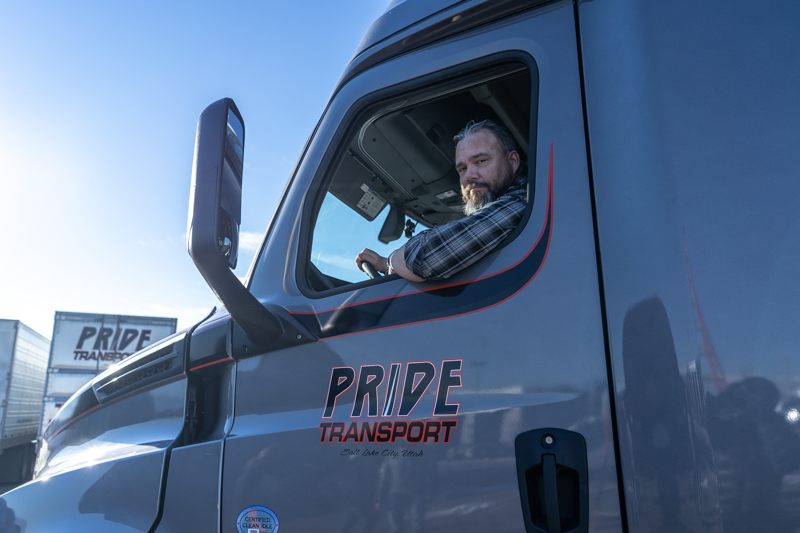by Pride Transport | May 09, 2025
Medical emergencies behind the wheel can cause serious accidents and endanger both the truck driver and everyone else on the road. And these emergencies don’t just happen to drivers with existing health issues, even the healthiest drivers could experience a medical emergency! That’s why ensuring driver health and medical safety should be a team effort between drivers and trucking companies.
For drivers, that means taking care of themselves to the best of their ability. For trucking companies that means using the latest in-cab technologies designed to detect and prevent medical issues. Keep reading for a closer look at the tech solutions that drivers and companies can use to better protect themselves and the driving public.
Technology for Monitoring Driver Health
Some driving jobs may require physical activity throughout the day (helping to load and unload cargo, for example), but for many drivers, especially those covering over-the-road or other types of long-haul routes, most days are spent behind the wheel.
Drivers might not be able to get in their daily steps, but they can still stay on top of their health. With the right technology, truck drivers can monitor important health indicators and make adjustments to maintain medically-approved healthy lifestyles. Here’s how truck drivers are putting health tech to work for them.
Wearable health monitors
For a long time, the most widely available wearable health monitors were step counters. While these were (and still are!) useful reminders for getting people up and moving, their capabilities pale in comparison to today’s health technology. Now, people can choose from a wide range of smartwatches and fitness trackers that measure and monitor everything from heart rate and blood pressure to oxygen levels and sleep patterns.
Most wearable health monitors can sync with your phone and provide regular notifications and real-time alerts if it detects noticeable or concerning changes in your health. There are several reported stories of fitness trackers tipping people off to heart conditions and other health issues they didn’t know about, and wouldn’t have caught without a nudge from their health device.
In-cab biometric sensors
Not all health monitoring falls on the driver, though. Innovations in truck cab technology include in-cab biometric sensors that detect signs of fatigue, stress, or sudden medical events. Seat-based and steering wheel sensors can detect and track an individual driver’s vital signs and offer a more personalized assessment of driver health. Biometric sensors are gaining popularity in both commercial and standard vehicles, so truck drivers may see these systems become standard over the next several years.

Improving Response Times to Medical Emergencies
Monitoring driver health goes a long way in helping to reduce the chances of both medical emergencies and accidents resulting from emergencies, but additional help is needed in case the worst does happen. That’s where preventative and emergency response technologies can make a difference.
The Federal Motor Carrier Safety Administration (FMCSA) categorizes various advanced driver assistance systems (ADAS) into four categories: braking, steering, warning, and monitoring. Whether these systems are used separately or in combination, all of them offer solutions that can help to minimize the chance of driving accidents. Below are some of the most common technologies currently keeping drivers safer.
Automated emergency braking and lane assist
Automated emergency braking systems and lane assist are crucial components of driver safety. Heavy-duty commercial vehicles have a lot to contend with on public roadways, and responsible truck drivers can’t control how well other vehicles share the road. Automated braking and lane assist mitigate the risk of collisions by alerting truck drivers when other vehicles are getting too close and even stopping the vehicle if absolutely necessary.
Automatic braking is even more important if the driver has a medical emergency and isn’t able to brake on their own. If the driver isn’t responding to alerts and warnings, the system can take over and slow down or stop the vehicle to reduce the possibility of further accidents.
Medical emergency alert systems
When an accident occurs, time is of the essence. Emergency vehicle alert systems can help clear the way for emergency vehicles to respond to the scene of the accident and provide potentially life-saving care. These GPS-integrated emergency systems notify motorists that emergency vehicles are approaching or in the area, alerting drivers to pay extra attention to their surroundings and prepare to pull over if needed.
Real-time health data sharing with fleet managers
Telematics systems use GPS technology and onboard diagnostics to monitor driver health and safety remotely. Using in-cab connected devices, fleet managers can stay connected to drivers and monitor operations to ensure that drivers are en route and operating their vehicles safely.
Although telematics can be incredibly useful for fleet management, there are concerns in the industry about balancing safety and driver privacy. For example, GPS tracking can be used to confirm that drivers are progressing on their route as planned, but telematics can also show what the truck is doing at any time and place, which can create a sense of distrust if the protocols for using telematics aren’t clearly outlined and communicated.
Pride’s Commitment to Health and Safety
At Pride Transport, we take driver health and safety seriously. That’s why our trucks are equipped with some of the latest technology to make sure every mile is the safest one yet. We use the SmartDrive transportation intelligence platform to help ensure safety for our entire fleet, and Detroit Assurance provides top-notch on-road safety by integrating with the truck’s systems to take action to help mitigate collisions.
Drivers know their safety comes first when they drive with Pride. And the good news is, we’re hiring! Check out our open driver positions and join the team today.
